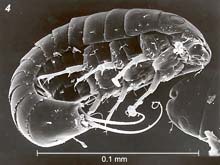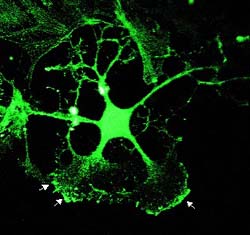Life Sciences and Chemistry
Articles and reports from the Life Sciences and chemistry area deal with applied and basic research into modern biology, chemistry and human medicine.
Valuable information can be found on a range of life sciences fields including bacteriology, biochemistry, bionics, bioinformatics, biophysics, biotechnology, genetics, geobotany, human biology, marine biology, microbiology, molecular biology, cellular biology, zoology, bioinorganic chemistry, microchemistry and environmental chemistry.

UC Riverside Plant Cell Biologists Show that Plants Use Unique Mechanisms to Process and Degrade Proteins
In plants, many proteins are degraded or activated within the vacuole, a large water and nutrient-filled vesicle found in plant cells that helps maintain the shape of plant cells and that stores food molecules. The manner by which this degradation or activation occurs, however, is uncertain.
In the June 10, 2003, issue of the Proceedings of the National Academy of Sciences (PNAS), however, scientists from UC Riverside identify a key protein, vacuolar processing enzyme or VPEg, in Arabidops

Growing green gold
A new way to make gold form inside the cells of a micro-organism is published today in the Institute of Physics journal Nanotechnology. Researchers from the National Chemical Laboratory and the Armed Forces Medical College, both in Pune, India, have been using “green chemistry” to develop an eco-friendly way to make tiny gold particles without using toxic chemicals.
Such gold nanoparticles of uniform size can be used in labelling proteins, nucleic acids and other biomolecules, which could l

"Kiss-and-Run" Rules the Inner Lives of Neurons
Neurons transmit chemical signals in a fleeting “kiss-and-run” process, which in large part determines how quickly neurons can fire, according to new studies by Howard Hughes Medical Institute researchers.
The transfer of information between nerve cells occurs when chemicals called neurotransmitters are released into the synapse, the junction between neurons. Electrical impulses in the neuron cause tiny vesicles loaded with neurotransmitters to move to the tip of the nerve terminal where th

Bizarre bug wears host’s skin
Oxford scientists have discovered a particularly macabre method one parasite (Strepsiptera) has for disguising itself in its insect host: it wraps itself in a piece of the host’s own body tissue. In this way the strepsipteran masquerades as ‘self’, and is protected from the insect’s immune system.
The mechanism whereby Strepsiptera flourish without interference from the host has so far been a mystery. Scientists have been intrigued by the exceptional diversity of host insects exploited by th

Protein linked to brain cell scarring after injury
A new study links a protein discovered a few years ago at the University of North Carolina at Chapel Hill with formation of scar tissue that occurs after injury to nerve cells in the brain or spinal cord.
Such scarring apparently blocks neurons of the central nervous system from recovering after traumatic injury – inhibiting their axon filaments from regenerating and ferrying nerve impulses elsewhere, to other neurons and tissue, including muscle. Loss of nerve cell function and paralysis ca

Cloning embryos from cancer cells
St. Jude researchers say reprogrammed nucleus model could offer valuable clues to how certain influencing factors combine with DNA mutations to cause tumors
Nuclei removed from mouse brain tumor cells and transplanted into mouse eggs whose own nuclei have been removed, give rise to cloned embryos with normal tissues, even though the mutations causing the cancer are still present. This research, from scientists at St. Jude Children’s Research Hospital, appears in the June 1 issue